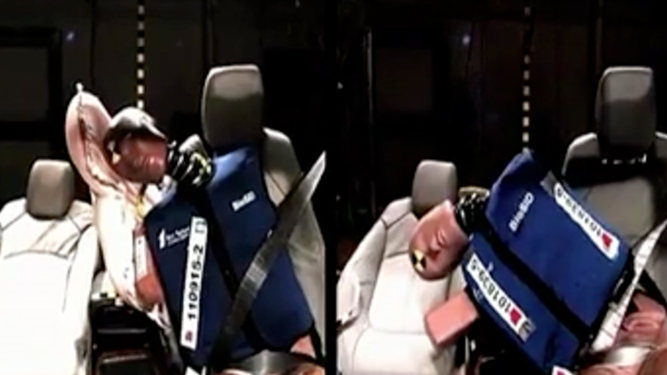The body lurches sideways. The neck bends in a U-shape. The seat belt and front airbag offer almost no help. These are the markings of a side-impact car accident.
Protecting occupants in side-impact crashes has been a problem that has vexed automotive safety engineers. These types of accidents are responsible for 39 percent of traffic fatalities involving belted occupants, according to a study of data collected from the Fatality Analysis Reporting System.
General Motors has a potential solution.
The automaker has introduced a first-of-its-kind airbag aimed at specifically protecting occupants from the forces of side-impact crashes. Like an over-sized hand reaching toward the sky, the Front Center Airbag unfurls from the lower right side of the driver’s seat and inflates upward, providing a barrier between front-seat occupants.
“I’m really proud of this,” said Scott Thomas, an advanced airbag systems engineer at GM who guided the new airbag through an arduous five-year development process. “I spent a lot of my spare time working at home on this.”
Unconventional thinking
It took longer than usual because nothing about this airbag resembles its more conventional counterparts: its figure-eight shape is unique, it is made out of a thicker material that provides more resistance than conventional airbags, and its tubular housing wedged inside the seat was created from scratch.
“From a geometry perspective, getting this sized properly and working properly was quite a challenge, and it took us much longer than usual,” Thomas said. “We had to have the airbag restrain the occupant from going sideways and we had a very limited reaction surface.”
This new life-saving technology made its debut on the 2013 Buick Enclave. Although no firm plans are yet in place, a GM spokesperson said she expects it will soon spread to more models in the Buick lineup. General Motors worked on the project with Takata, one of the largest automotive suppliers of airbags.
Traditional safety devices are less effective. Because of the side force, it is easy for occupants to slide out of a shoulder strap and away from the cushion provided by a steering-wheel deployed airbag.
Thomas has been working on seat belts and airbags at GM his entire career. Thomas said his interest in automotive safety began when three girls at his high school died in a car crash. As a student at Ohio State, he worked on the chest of a 6-year-old child-sized crash-test dummy for his master’s thesis.
“I initially started on seat belts, and have since focused more extensively on airbags, as I’ve found them to be a good challenge and a satisfying means through which to help society,” he said.
Challenges
One of the key challenges on this project, previously unknown in airbag technology, was getting the airbag to deploy far enough in an outward direction direction before it curves back toward the driver.
Another challenge was protecting both front-seat occupants. Of the side-impact fatalities, 71 percent occur to the occupant nearest the crash, but 29 percent of the fatalities are seated on the far side of the crash.
One reason for that was the occupants collided with each other, so GM desired to keep the occupants apart. Forty-two percent of the fatalities occurred when both front seats were occupied. The Front Center Airbag is one of a few airbags that can benefit more than one occupant at the same time.
Takata initially began work on the project and had the basic structure of the figure-eight patented when they were approached by GM about the project. Working with its partners at Takata, GM spent years refining the design. They had to not only invent the technology, but figure out how to develop testing procedures.
“It required much innovative thinking during its development,” Thomas said.



